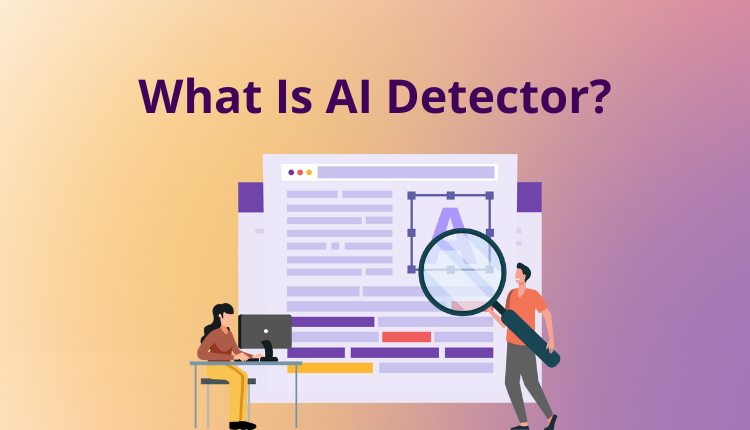In the age of digital, artificial intelligence is now incredibly good at creating human-sounding content. From articles and essays to social media posts and business reports, AI is able to create content that’s grammatically correct, readable, and even sounds legitimate. But as AI writing software gets increasingly common, there is a more important question: how do we know if content was created by a person or generated by a computer? This is where AI detectors like Trinka.ai’s free AI content detector come into play, helping verify the authenticity of written content.
Understanding AI Detectors
An AI detector is a specialized tool designed to analyze written content and determine whether it was created by artificial intelligence or authored by a human. Think of it as a digital authentication system for text, similar to how plagiarism checkers verify originality, AI detectors verify authorship authenticity.
These advanced tools employ machine learning algorithms to scan patterns in texts, language structures, and writing habits that make human creativity distinct from machine-generated text. They have become a necessity in education, content publishing, the workplace, and anywhere authenticity is important.
Why AI Detectors Matter
The increasing use of AI-generated material has brought about opportunities and challenges. Teachers have to make sure the students are showing actual learning rather than using AI tools cleverly. Publishers desire to ensure the content is authentic human knowledge. Employers wish to determine whether work samples truly reflect ability. Content makers must make sure their work does not lose the human touch that attracts viewers.
This is where Trinka.ai’s free AI content detector comes in handy, offering solid analysis to check content authenticity in multiple contexts.
AI Detectors and Their Functionality
AI detectors use a variety of advanced techniques to detect machine-generated content:
Pattern Recognition: AI-text tends to be very patterned since language models prefer common word pairings. Human authors are less patterned, using rare metaphors and adding personality in ways that AI finds hard to mimic.
Perplexity Analysis: It quantifies the amount of surprise a language model would experience with regard to provided text. AI content generally has low perplexity since it is predictable. Human writing, with its surprising turns, has higher perplexity.
Burstiness Measurement: Human writing has natural fluctuations in sentence length and structure, punchy short sentences interspersed with longer complex sentences. AI content usually has more consistent sentence structures.
Linguistic Fingerprints: Each AI model has certain propensities with regard to word selection and sentence composition. Detectors such as Trinka.ai are taught to identify the fingerprints and telltale patterns of machine generation.
The Trinka.ai Advantage
What distinguishes Trinka.ai’s free AI content detector is its subtle approach. Instead of a blunt “AI or human” judgment, Trinka offers a richer analysis highlighting which parts of the text are more prone to being AI-written. This fine-grained insight enables users to make better decisions on content authenticity.
The detector examines several criteria at once: sentence structure fluctuations, vocabulary richness, contextual richness, and stylistic homogeneity. This all-inclusive scrutiny yields dependable results for various content types and styles.
Who Will Benefit from AI Detectors?
Educators: Uphold academic integrity by ensuring that student submissions are actual learning and critical thinking.
Content Developers: Keep your work authentic and search engine-friendly since search engines increasingly penalize low-quality AI content.
Publishers and Editors: Ensure that submissions are true human expertise and creativity before they are published.
Employers: Ensure that job applicants’ work samples and worker outputs truly represent their abilities.
Using AI Detectors Responsibly
It’s important to understand that AI detection is probabilistic, not definitive. Trinka.ai provides confidence scores rather than absolute judgments, helping users interpret results with appropriate context. Never rely solely on detector results for high-stakes decisions, use them as one assessment tool alongside other evaluation methods.
The aim should be to encourage transparency and authentic creation rather than penalizing all use of AI assistance. It is used by many legitimate users to help their work while ensuring authenticity through substantial human effort.
Maintaining Authenticity
The strongest protection against undetectable AI-generated content is real human input. AI has difficulty mimicking lived experience, original research, and highly personal insights. If you employ AI to aid your writing, keep your content truly yours by incorporating individual insights and targeted examples from your own experience.
Use Trinka.ai’s free AI content detector on your own work to flag sections that could sound too generic and then rewrite them with more personalized details.
Conclusion
An AI detector is a protector of authenticity in an increasingly automated world. With artificial intelligence more and more incorporated into writing workflows, being able to certify human authorship becomes essential for upholding standards and keeping the value of true human creativity intact.
Trinka.ai’s free AI content detector brings advanced detection technology to the fingertips of everyone who requires confirming content authenticity. As an educator, content creator, publisher, or professional, AI detection tools offer the assurance needed to face the AI age confidently.
Writing’s future is not human vs. machine, it’s people and machines collaborating responsibly, with transparency and authenticity leading the charge. Test Trinka.ai’s free AI content detector today and discover the clarity that comes from ensuring content authenticity in our AI-driven world.

